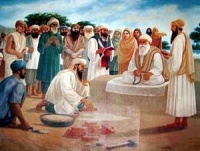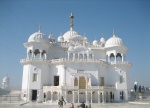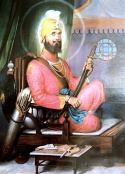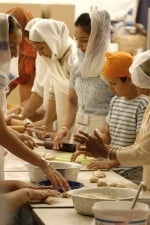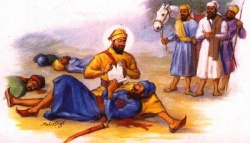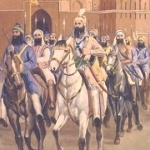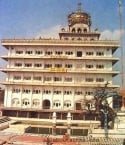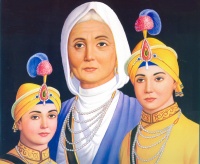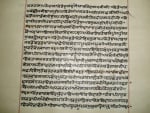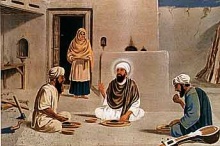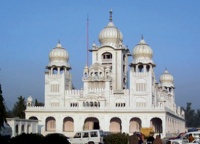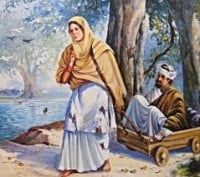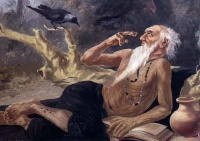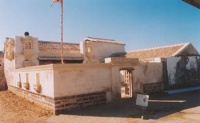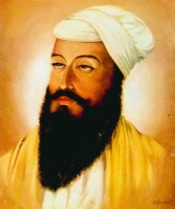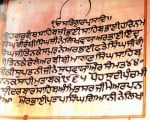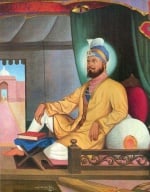SikhiWiki:Today's featured article/January 2009
Today's featured article archive
2007 -
2008 -
2009 -
2010 -
January - February - March - April - May - June - July - August - September - October - November - December
Today is Friday, April 19, 2024; it is now 18:14 UTC
Featured content:
| << | Today's featured articles for January 2009 | >> | ||||
| Su | Mo | Tu | We | Th | Fr | Sa |
| 1 | 2 | 3 | ||||
| 4 | 5 | 6 | 7 | 8 | 9 | 10 |
| 11 | 12 | 13 | 14 | 15 | 16 | 17 |
| 18 | 19 | 20 | 21 | 22 | 23 | 24 |
| 25 | 26 | 27 | 28 | 29 | 30 | 31 |
- January 1
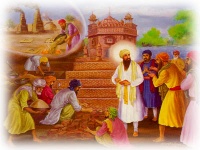
Dasvandh or Dasaundh, literally means a "tenth part" and refers to the practice among Sikhs of contributing in the name of the Guru one-tenth of their earnings towards the common resources of the community.
This is their religious obligation — a religious requirement or duty; a form of seva or humble service which is highly valued in the Sikh system.
The concept of dasvandh was implicit in Guru Nanak’s own Gurbani in the line: "ਘਾਲਿ ਖਾਇ ਕਿਛੁ ਹਥਹੁ ਦੇਇ ॥ ਨਾਨਕ ਰਾਹੁ ਪਛਾਣਹਿ ਸੇਇ ॥੧॥ One who works for what he eats, and gives some of what he has - O Nanak, he knows the Path (1)" (SGGS p 1245)
The idea of sharing and giving is symbolised by the institutions of langar (community kitchen) for the sangat (holy assembly) that the Guru has established.
In the time of Guru Amar Das, Nanak III, a formal structure for channelizing Sikh religious giving was evolved. The Guru set up 22 manjis or districts in different parts of the country, each placed under the charge of a pious Sikh who, besides preaching Guru Nanak's word, looked after the sangats within his/her jurisdiction and transmitted the disciple’s offerings to the Guru. .....More
view – talk – edit – history
- January 2
One of Guru Gobind Singh’s main gifts to the world was the message of unity and equality of all the peoples of the world.
The Guru was responsible for creating unity among the peoples of Punjab and for the spreading of the message of the universal brotherhood of the human race.
The Hindus, Muslim, Sikhs and others felt that they were treated fairly and equally within the domain of the Guru. The Guru’s mission was centred on Anandpur Sahib, which became the main centre of development during the time of the tenth master.
Prior to the arrival of the Guru, this region was predominately an area occupied by Hindus, where the Brahmanic brand of caste distinction was rigidly observed. Fellow human beings within the same religion worked against each other and against other religious groups. Wars and skirmishes were a common occurrence. However, slowly and steadily this mood of agitation was changed with the introduction of a recognition of the unity of man. .....More
view – talk – edit – history
- January 3
Hazrat Mian Mir was a famous Muslim Sufi saint who lived in Lahore. He was born at Sevastan (Sindh) in 1531 AD.
Due to the high esteem and great respect for the Sufi saint, the fifth Sikh Guru, Guru Arjun Dev asked Mian Mir to lay down the foundation stone of Harmandir Sahib, the main Sikh shrine in the world.
The ceremony duly took place on 3rd January 1588 AD, when Sai ji laid down the foundation stone at Amritsar over 420 years ago. Thus began the history of the most famous Sikh shrine and the occasion crystallised the very important message of true interfaith respect and close dialogue among the different peoples of faith in the world.
Guru Arjan Dev was responsible for the construction of many tanks and buildings in Punjab. In 1588, he planned to build an impressive temple in the centre of the holy tank called Amritsar or the pool of nectar. As the temple was to be thrown open to people of all castes, creeds and climes, he invited Mian Mir who was a close friend of the Guru to lay the foundation stone of this shrine. .....More
view – talk – edit – history
- January 4
The Six Qilas (or Forts) of Anandpur sahib are the six forts which were constructed by Guru Gobind Singh, during the 25 years that the Guru spent at Anandpur sahib. The neighbouring hill Rajas and their Mughal allies became increasingly hostile towards the success of the Sikh community thriving in their midst.
Seeing the need to protect Anandpur from its hostile neighbours the Guru ordered the construction of a series of six defensive forts (Qilas in the Persian language). One central fort with five others encircling the town. There were several other minor forts around the city, but the five forts encircling the fort surrounding the city were the main defensive forts that bore the series of attacks and seige that led to the Guru's eventual decision to leave the city under its attackers solemn promises of safe passage to Punjab.
The six forts constructed by Guru Gobind Singh at Anandpur sahib are:
- Keshgarh - Keshgarh.
- Lohgarh (fort of steel) - Lohgarh,
- Agamgarh or Holgarh (fort of colour) - Agamgarh or Holgarh,
- Anandgarh (fort of bliss) - Anandgarh.
- Fatehgarh (fort of victory) - Fatehgarh and
- Qila Taragarh - Taragarh ' .....More
- January 5
On January 5 this year the world celebrates the birth in Patna, India of the tenth and last of the Ten Gurus in human form of Sikhism.
Gobind Rai was born on January 5, 1666 and became Guru on November 11, 1675 at the age of nine, following in the footsteps of his father Guru Teg Bahadur.
The Guru moulded the Sikh religion into its present form with the formation of the Khalsa in 1699.
The tenth Guru (teacher) of the Sikh faith, was born Gobind Rai. It may not be out of the way to say here that throughout the annals of human history, there was no other individual who could be of more inspiring personality than Guru Gobind Singh.
Guru ji infused the spirit of both sainthood and solider in the minds and hearts of his followers to fight oppression and support righteousness (Dharma) in order to restore justice, peace and to uplift the down-trodden people in this world. In the short 42 year of life and a Guruship of only 33 years, the Guru contributed immensely to Sikhism and to the world and his gift to all the peoples of the world still remains unmatched to this day. .....More
view – talk – edit – history
- January 6
Gurdwara Panja Sahib is situated at Hasan Abdal, 48 km from Rawalpindi in Pakistan. This is one of the most holy places of Sikhism because it marks the spot where the founder of the faith, Guru Nanak Dev visited and instilled an important lesson for his adherents. Still visible is the sacred rock with the hand print of Guru Nanak.
Many thousands of faithful Sikhs from all over the globe visit this shrine every year. However, twice a year, during special celebrations, an enormous number of Sikh pilgrims attend this Gurdwara from every corner of the world. Special visas are allocated by the Pakistan government to cater for the increased demand.
Guru Nanak along with Bhai Mardana reached Hasan Abdal on Baisakh Samwat 1578 B.K. corresponding to 1521 A.D. in the summer season. Under a shady cool tree, Guru Nanak and Bhai Mardana started reciting Kirtan and their devotees gathered around. This annoyed Wali Qandhari but he was helpless. ....Continued.
view – talk – edit – history
- January 7
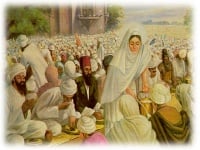
Mata Khivi (1506 - 1582) was born in 1506 to Karan Devi and Bhai Devi Chand Khatri in a small town called Sanghar which is now located in the province of Sindh in Pakistan.
Her father was a shopkeeper and trader, and was a popular man in the neighbourhood. His daughter inherited all his finest attributes of generosity and congenial spirit.
She was married in 1519, when she was 13 years old. Khivi was married to Lahina for 20 years before he became the second Guru of the Sikhs.
There is historical evidence that she had 4 children. Dasu, the eldest was born in 1524. Bibi Amro was born in 1532, followed by Bibi Anokhi in 1535 and son Datu in 1537. The family was content and doing well. As the wife of one of the town's richest men, Khivi must have enjoyed a great deal of respect. Her life was one of luxury and pleasure. .....More
view – talk – edit – history
- January 8
A Sikh is required by the Sikh Gurus to live a disciplined and ordered life by doing pure and righteous deeds and actions. The following are activities that a Sikh should engage in:
Read Gurbani - The initiated Sikh is asked by the Panj Piare during the Amrit Sanchar ceremony to recite the 5 banis every morning as a commitment to the Sikh Gurus and Waheguru.
Wear the 5Ks or panj kakaar/kakke: These are the five items of faith that a baptised Sikh wears at all times as per the command of the tenth Sikh master, Guru Gobind Singh. The Five Ks are not merely symbols but articles of faith which collectively form the external visible symbols to clearly and outwardly advertise, display and identify the love of the Sikh for the Guru.
To kill the 5 Evils or five thieves referred to in Sikh Scripture; these are the five major weaknesses of the human personality at variance with its spiritual essence. They are: Kam (Lust), Krodh (Rage), Lobh (Greed), Moh (Attachment) and Ahankar (ego).
Practice the 5 Virtues - For Sikhs, the final goal of life is to reunite or merge with God (Mukti). The Sikh Gurus taught that to achieve this goal it was important to work hard at developing positive human qualities which lead the soul closer to God.
Simran and Sewa and also Three Pillars: Naam Japna, Kirat Karni and Vand Chakna .....More
view – talk – edit – history
- January 9
Nawab Kapur Singh (1697-1753) is considered one of the most revered, pivotal and legendary figures in Sikh history post 1716.
Under his leadership decisions and courage, the then tiny Sikh community went through some of the darkest periods of its history.
The founding father of the Sikh Confederacy and Sikh Empire, he was also the founder of the Dal Khalsa.
Alongside Banda Bahadur who dominated the seen before him, he laid the foundations of the Sikh Empire and the eventual over-through of the vicious Mughal Empire. Today, he is regarded by Sikhs to be of equal importance to Banda Singh Bahadur.
The period, starting from the massacre (in 1716) in Delhi of Banda, his son, seven hundred of his devoted army members and thousands of Sikhs taken captive or beheaded along the march to Delhi, was followed by severe action against the Sikhs by the rulers, including massacres of young men, women and children. .....More
view – talk – edit – history
- January 10
Seva or Karseva also shortened to ‘Sewa’ is a word used to refer to "selfless service", performed without any thought of reward or personal benefit.
The person performing this service is called a Sevadar. All Sikhs are encouraged by their Guru (Sri Guru Granth Sahib) to perform Seva or Selfless Service.
This is not only good for the community but is also good for the moral uplifting of the person performing the service. You will find Sikhs engaged in free service in Gurdwaras washing dishes, performing kirtan or cleaning the floors, etc.
Sikhs are also encouraged to help the community by performing unpaid work in hospitals, old peoples' homes, community centres, etc. Volunteers engaged in Seva or Sevadars find that this activity forms an essential part of their life, providing spiritual fulfilment and practical benefits.
Sikhism is founded on principles of "Sarbat da bhalla" - "working towards the common good". For Sikhs, this means reaching out to serve and to uplift all of humanity as an expression or devotion to the Creator. Many other Sikh institutes like Guru-ka-Langar, Kirtan, Paath, etc depend on the performance of Seva by many in the congregation. So the principles of Seva underpins many of the Sikh values and institutions - Such is the importance given to Seva in Sikhism. .....More
view – talk – edit – history
- January 11
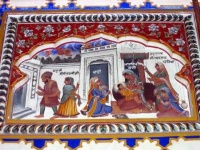
Mata Tripta was Guru Nanak's mother. The history of Sikh women has to start with her. She was the person who brought Guru Nanak, the founder of the Sikh religion into the world.
In the annals of world history, the greatness of Mata Tripta, deserves to be celebrated for bringing to the world a soul who offered much spiritual and moral guidance and a solid and creditable foundation for a new world religion.
Mata Tripta and her husband Mehta Kalu lived in Talwandi, Punjab, which is now part of Pakistan. Weary saints and 'fakirs' would take rest here, and Mata Tripta would welcomed and serve all these passers-by.
Their dedication for service of others was finally rewarded when Nanak was born in 1469. Thus, Mata Tripta was blessed with the honour of giving birth to God's messenger, Guru Nanak, whose mission was to redeem mankind.
No poet has ever been able to convey the ethereal beauty attained by Mata Tripta when she was expecting Nanak. Of the many prophets that have visited the earth, many of their mothers were unable to celebrate in the joy of rearing such wondrous offspring. For example; in Hinduism, Mata Devaki, the mother of Krishan, was unable to fulfil her maternal role as she languished in jail. She yearned for her child, and he too missed the love of his mother. .....More
view – talk – edit – history
- January 12
Anandpur Sahib was founded in 1664 by Guru Tegh Bahadur Sahib Ji. The city is situated at the foot of the Shivalik mountain range on the banks of the River Sutlej.
Guru Gobind Singh ji grew up here and protected the city by constructing a chain of forts - Kesgarh, Anandgarh, Lohgarh, Holgarh and Taragarh.
It was at Anandpur Sahib that Guru Ji trained his Sikhs in the art of warfare and created special knight-errants the Nihangs. But Takhat Sri Kesgarh Sahib, Anandpur will always be best remembered for the creation of Guru Ji's order of the Khalsa.
In the inner sanctum of Takhat Sri Kesgarh, Anandpur Sahib are kept the shastras (weapons) associated with Guru Gobind Singh Ji. These weapons are taken out in the evenings and shown to the sangat.
- The historic Khanda associated with the amrit ceremony on Vaisakhi 1699
- Karpa Barsha. In the year 1673 when Guru Sahib Ji was engaged to Mata Jito Ji, Guru ji's father-in -law wanted the marriage party to go to Lahore. However, instead of going to Lahore Guru Ji established a new township near Anandpur Sahib and named it Guru Ka Lahore. When the residents complained of water shortage, Guru Ji struck the ground with this very barsha and water came gushing out. .....More
- Karpa Barsha. In the year 1673 when Guru Sahib Ji was engaged to Mata Jito Ji, Guru ji's father-in -law wanted the marriage party to go to Lahore. However, instead of going to Lahore Guru Ji established a new township near Anandpur Sahib and named it Guru Ka Lahore. When the residents complained of water shortage, Guru Ji struck the ground with this very barsha and water came gushing out. .....More
- January 13
Magh
Magh is the eleventh month in the Nanakshahi calendar and governs the activities of the Sikhs during the Winter period and dictates events within Sikhism.
This month coincides with January/February of the Western/Georgian/Julian Calendar and is 30 days long. The month of Marg starts on the 13 of January and ends on the 11 of February.
The Guru tells us that in the month of Magh (January/February): "...let your cleansing bath be the dust of the Saadh Sangat, the Company of the Holy. Meditate and listen to the Name of the Lord, and give it to everyone. In this way, the filth of lifetimes of karma shall be removed, and egotistical pride shall vanish from your mind. Sexual desire and anger shall not seduce you, and the dog of greed shall depart. Those who walk on the Path of Truth shall be praised throughout the world. Be kind to all beings-this is more meritorious than bathing at the sixty-eight sacred shrines of pilgrimage and the giving of charity. That person, upon whom the Lord bestows His Mercy, is a wise person. Nanak is a sacrifice to those who have merged with God. In Maagh, they alone are known as true, unto whom the Perfect Guru is Merciful. ((12))"
(SGGS page 135) .....More
view – talk – edit – history
- January 14
Nadir Shah's brutal offensives and the eight invasions by Ahmed Shah Abdali had made the Mughal Empire fragile and weak.
Sikhs had emerged as a strong and powerful force in northern India, and eventually halted Abdali's invasions. Under the leadership of Dal Khalsa chief, Sardar Jassa Singh Ahluwalia, the Sikhs refused an alliance, and instead challenged Abdali for battle.
They were anxious to avenge the killing of over 20,000 Sikhs, mostly women, children and old people, and also the destruction and desecration of the Golden Temple. Sensing defeat, Abdali called it a day, and finally returned to Afghanistan, never to come back again.
The vast area of the Indian subcontinent lying between the Indus and the Yamuna thus became free from foreign rule. With no enemy in the North, and Shah Alam II at the head of the decaying Mughal Empire at Delhi, the powerful 12 misls had a free run in increasing their influence in all directions, from the Indus to the Yamuna, seeking 'rakhi' (tribute, protection money) from various small chiefs, nawabs and rajas. .....More
view – talk – edit – history
- January 15
ASA KI VAR, is the term recorded in the index to the Guru Granth Sahib but this Gurbani is commonly called "Asa di Var". It is found in the Sikh scripture from page 462 line 17 to page 475 line 10.
The composition is by Guru Nanak, the founder of Sikhi and is usually sung by kirtania (religious musicians) at Sikh congregations or gatherings as part of the early morning service.
This Var is a heroic ode which describes the brave deeds of a hero. It is generally sung to inspire armies going to battle or to inspire people with martial spirit. The tempo of this bani when sung is very measured and positive inspiring a spirit of chardikala in the congregation.
The kirtan is very melodious and the style as mentioned by Guru Arjan is called "Tunde Asraje ki Dhuni" after the name of the contemporary brave and pious Indian king Asraj. One of the hands of the king was amputated, so he was called 'Tunda' meaning crippled. .....More
view – talk – edit – history
- January 16
Many sacred Sikh shrines can be found in the Sikh holy city of Amritsar. Of particular importance are the five sacred pools in this city.
These are called sarovars and it is the practice of some Sikhs to have a dip in all five of these holy pools. The ritual, apart from being good exercise, acquaints one with the importance of these five sites.
These five holy Sarovars are: Amritsar (1586) (now used more to refer to the city rather than the sarovar), Santokhsar (1587-88), Ramsar (1602-03), Kaulsar (1627), Bibeksar (1628). Among these famous five historical shrines is the famous Gurdwara, Ramsar. This is located south to south-east of the most important landmark for the Sikhs, Harimandir Sahib.
Alongside the Ramsar Gurdwara is situated the smallest of the five sarovars called Ramsar. This is the location where in 1603, Guru Arjun Dev, the fifth Sikh Guru spent over a year in semi-seclusion along with his scribe, Bhai Gurdas to compile the holy Adi Granth, the sacred Sikh scripture for the first time. .....More
view – talk – edit – history
- January 17
Mata Gujri (1624 -1705) (whose formal name was 'Mata Gujar Kaur') was the wife of the ninth Sikh Guru, Guru Tegh Bahadur; the mother of the tenth and last human Sikh Guru, Guru Gobind Singh and the grandmother of the four Sahibzade.
She was born in 1624 and was the daughter of Bhai Lal Chand Subulikka and Bishan Kaur, a pious couple of Kartarpur, in present-day Kapurthala district of the Punjab. Her role in the development of the Sikh faith has been crucial.
She was the wife of a supreme martyr; mother of a brave saint-soldier; and the grand-mother of four amazing children who all attained martyrdom at the ages of 6, 9, 14 and 18 years. She had been close to the two younger sahibzade and took up their guardianship in the flight from Anandpur under a promise of safe passage to Punjab. Imprisoned in the Thanda Burj of Sirhind with her youngest grandsons Zorawar and Fateh Singh, she attained martyrdom, at the age of 81 years, when she was told of their execution. .....More
view – talk – edit – history
- January 18
Bhai Himmat Singh (18 January 1661- 7 December 1705), was one of the original Panj Piare (the Five Beloved) the first five Singhs to be initiated into the Khalsa way of life.
He was born on 18 January 1661 at Jagannath in a "low-caste" family of water suppliers. He came to Anandpur at the young age of 17, and attached himself to the service of Guru Gobind Singh.
Before initiation, he was called 'Bhai Himmat'. He was one of the initial five Sikhs who one by one offered to lay down their heads in response to the Guru's successive calls made at an assembly of the Sikhs especially summoned on the occasion of Baisakhi of 1756 Bk corresponding to 14 April, 1699.
He along with the other four received the vows of the Khalsa at Guru Gobind Singh's hands and was given the name Himmat Singh.
Bhai Himmat Singh proved himself to be a brave warrior and while at Anandpur, he took part in battles with the surrounding hill chiefs and imperial commanders. He died in the battle of Chamkaur on 7 December 1705 together with Bhai Sahib Singh and Bhai Mukham Singh also members of the historic Panj Pyares. .....More
view – talk – edit – history
- January 19
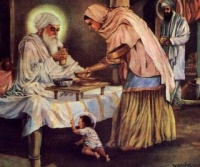
Bibi Bhani ji (1535 - 1598) was born to Guru Amar Das and Mata Mansa Devi on 19 January 1535 (21 Magh 1591 Bk) at Basarke Gillan, a village some 13 kms south-west of Amritsar. She had an older sister called Bibi Dani and two brothers called Bhai Mohan and Bhai Mohri.
She was married on 18 February 1554 to Bhai Jetha (who later became Guru Ram Das), a Sodhi Khatri from Lahore. Bhai sahib later moved to Goindval which was an upcoming Sikh town and carried out voluntary service (Sewa) in the construction of the Baoli Sahib (deep walk-in well).
When Guru Amar Das had first seen Bhai Jetha, he had been very impressed with the dedication to the sangat (congregation) and the Sewa performed by him. And so observing the purity of his kind soul, a marriage was arranged between Bibi Bhani, Guru ji's daughter and the dedicated devotee, Bhai Jehta. After marriage, the couple remained in Goindval serving the Guru, doing sewa and serving the (sangat).
Later, on the near completion of the Gurdwara at Goindval, Bhai Jetha was deputed by the Guru to go and establish a habitation at present-day Amritsar. This place was also later called "Ramdasar". Here, on a piece of land gifted, according to one version, to Bibi Bhani by Emperor Akbar at the time of his visit to Guru Amar Das, Jetha ji expanded a natural pool into a Sarovar. .....More
view – talk – edit – history
- January 20
Meditation is any practice whose goal is attaining a state of higher consciousness. It is the process of retraining our awareness to operate not from the conscious or subconscious level, but from the level of the super-conscious.
Guru Amar Das warns us about our attachment to material things thus: "The three qualities hold people in attachment to Maya. The Gurmukh attains the fourth state of higher consciousness." (SGGS p30).
To attain this higher level of consciousness, one has to disengage the mind away from mundane interactions and join it to a much higher level of awareness.
When considering awareness, it is clear that man is more aware of his surrounding than animals. Man is conscious of his parents, grand-parents and other relatives while animals in general may not be so conscious about some of the complex relations that they may have.
Most animals’ behaviour is driven by their immediate sensory needs while most human behaviour is driven by etiquette and social norms rather than sensory demands. The concept of correctness and fairness has crept in - this can be termed 'consciousness'. .....More
view – talk – edit – history
- January 21
The Sarbloh Granth (Punjabi: ਸਰਬਲੋਹ ਗ੍ਰੰਥ, sarablŝha granth) is a collection of poems (shabads) that recites the story of gods and demons, and is said to be the work of Guru Gobind Singh.
Sarbloh Granth literally means "the Granth or Scripture of all-steel (or iron)". However, many scholars and researchers question the authenticity of the Granth and its credibility remains in doubt.
According to Pandit Tara Singh Narotam, a nineteenth century Sikh scholar and researcher, the Sarbloh Granth is the work of Bhai Sukha Singh, a granthi (priest) at Takht Sri Patna Sahib. Bhai Sukha Singh, however claimed that he had acquired its manuscript from an Udasi recluse living in a forest near Jagannath Puri (Orissa).
The Akali Nihang tradition who make use of the Granth holds that whereas the Guru Granth Sahib is the embodiment of "Shaant Ras" (essence of peace), the Dasam Granth and the Sarbloh Granth are the embodiments of "Bir Ras" (essence of war). They believe that the difference between the Dasam Granth and the Sarbloh Granth is that although "Bir Ras" is born in the Dasam Granth, it is in the Sarbloh Granth where the individual warrior achieves an everlasting, final and complete lethal cutting edge advantage in this sphere of "Bir Ras". This Nihang belief is not accepted by the majority of the rest of the Sikh community.----> .....More
view – talk – edit – history
- January 22
After teaching people in Lahore to live honestly Guru Nanak ji returned to Talwandi to see his parents.
Then after a short stay, he proceeded with Mardana, his long time companion on a extensive journey to visit the sacred places of pilgrimage of the Hindus. On the way they reached Bhai Lalo’s workshop at Saidpur, presently known as Eminabad in Pakistan.
Bhai Lalo earned his living by honest work or Kirat Karni. He was nearly seventeen years older than Guru Nanak. When Lalo saw two holy men coming towards him, he put aside his work and spread a bed for them and went to get some food (or langar) for them.
As the kitchen was supposed to be the most pure and clean place in a house, Bhai Lalo asked Guru Nanak to come there and have his meal. Guru ji said “Bhai Lalo, every place is clean and pure for us. Please bring the meal here.” So the meal was brought out and Mardana then divided it into three parts and they all ate it together.
“This meal tastes like nectar. What has been put in it?” asked Bhai Mardana. Guru Nanak replied “That was the taste of truthfulness and honesty that you tasted. This taste is above the taste of worldly delicacies.” .....More
view – talk – edit – history
- January 23
This Gurdwara is situated at Kiratpur in district Rupnagar, Punjab, India.
It has been built on the banks of the river Sutlej and is situated across the railway tracks and is the place where many Sikhs take the ashes of their dead to be immersed in the river here.
Guru Hargobind in 1644 as well as Guru Har Rai in 1661 were cremated here. The ashes of Guru Harkrishan were brought from Delhi and immersed here in 1664.
The Gurdwara is located in a large plot of land measuring over 1km square and houses a large darbar sahib with a langar hall located near by. A small sarovar is located near the toilet and shower facilities. A footbridge is located to connect the devotees to the bank of the river.
Ample car parking space is available on the Gurdwara grounds. The main entrance to the Gurdwara is from behind the main building. Gardens and living rooms are located to the right of the main building. .....More
view – talk – edit – history
- January 24
In the era of Guru Ram Das ji, one cannot leave out Rajni, youngest daughter of Rai Duni Chand, revenue collector (kardar) of Patti.
Rajni was a Sikh, a disciple of the Guru. One day she was sitting with her sisters admiring some new clothing they all had received from their father.
The girls were ecstatic and exclaiming how good their father was to them. Rajni observed that all gifts are ultimately from God. Their father was merely an instrument of His greatness.
Unfortunately for her, her father overheard her comment and became very angry. It was not the first time that she incurred his wrath because of her extreme piety.
The infuriated father, believing her to be an ungrateful wretch, married her to a leper with a taunt that he would see how her God would help her lead a normal life. The leper was severely disfigured and a foul smell came from his body.
The poor girl had accepted her fate unchangingly and worked hard to maintain herself and her crippled husband.
She kept repeating the name of God (Naam Simran), and was certain that God was testing her with this turn of events. She was forced to beg for a living. Still she bathed, fed and cared lovingly for her leper husband, never losing faith. .....More
view – talk – edit – history
- January 25
There are 134 Shabads (hymns) of Sheikh Farid incorporated in the Guru Granth Sahib.
Many Sikh scholars ascribe them to Farid Shakarganj (1173 – 1265) of Pak Pattan, a disciple of the Sufi Qutbuddin Bakhtiyar Kaki.
The tenth in succession to his post was Shaikh Brahm (Ibrahim), also known as Farid Sani or Farid the 2nd, and it is this Farid who Guru Nanak Dev met on two occasions.
Baba Farid is recognised as the first major poet of the Punjabi language and in recognition of his exalted status, the district of Faridkot in Punjab, northern India is named after him. Baba ji was a Muslim with a predominantly Sufi background.
Farid ji has been honoured by the Gurus of Sikhism and his verses were collected and subsequently compiled into the Sikh holy book, Guru Granth Sahib (normally referred to as Gurbani) under three different sections as detailed below:-
First section: The first section consists of two shabads in Raag Asa at page 488 in the Guru Granth Sahib. The Bani starts " Aasaa, The Word Of Shaykh Fareed Jee:" "They alone are true, whose love for God is deep and heart-felt." .....More
view – talk – edit – history
- January 26

Baba Deep Singh Shahid (26 January 1682 -13 November 1757): Every year on January 26, the global Sikh community celebrate the birthday of this courageous soldier of God.
He is one of the most honoured martyrs in Sikh history and the founder of the Shahid Misl as well as of the Damdami Taksal. He was a tall, strong, and uncommonly brave Sikh who was a bold and fearless saint-soldier, ever ready to risk his life for the Panth.
- At eighteen, he received Amrit at Anandpur sahib in the presence of Guru Gobind Singh ji.
- He spent about 8 years and learned Gurmukhi from Bhai Mani Singh along with horse riding, archery as well as other arms training.
- Met Guru Gobind Singh at Damdama sahib where Guru Ji asked him to start preaching Sikhism. Later became head "Granthi" at Damdama Sahib.
- Between 1705 and 1728, Baba Deep Singh and Bhai Mani Singh produced a number of hand written copies of the Guru Granth Sahib.
- Fought in various wars - In about 1709, Baba Deep Singh Ji joined Banda Singh Bahadur to fight in the battle of Sirhind .....More
- January 27
Gurdwara Pehli Patshahi meaning the "Gurdwara of the first master" is situated at Lakhpat, Gujarat, India - A town in Gujarat, visited by Guru Nanak sahib during his second and fourth missionary journeys (Udasis) in 1506-1513 AD and 1519-1521 AD respectively.
"Gurdwara Guru Nanak Sahib" has been built to preserve the memory of these visits of revered Guru during the early 1500s. Guru Nanak is believed to have visited this site while he was on his way to Mecca during the Fourth Udasi. A few of his rare personal possessions are retained here.
In the course of Guru Nanak Dev ji's travels, he visited Gujarat and traveled onto Lakhpat. In those days, Lakhpat was part of Sind, which today is now part of Pakistan). Lakhpat is 170 kms from Gandhidham, Gujarat, India.
In the sixteenth century Lakhpat was known as "Basta Bandar". Lakhpat was then a rich rice growing area and was also a popular port along the river, but an earthquake in 1819 led to the area became barren and crops withered away due to a lack of water as the as the age old irrigation system failed when the riverbed shifted as a result of the earthquake. .....More
view – talk – edit – history
- January 28
- ਤਿਥੈ ਖੰਡ ਮੰਡਲ ਵਰਭੰਡ ॥ ਜੇ ਕੋ ਕਥੈ ਤ ਅੰਤ ਨ ਅੰਤ ॥
- "There are planets, solar systems and galaxies.
If one speaks of them, there is no limit and no end."
The Sikh scriptures have said great many things about the Universe.
However, although Gurbani has been in existence since about 1499 and the Guru Granth Sahib has been the Guru of the Sikh since 1708, the world has not been listening.
It is clear that there is very little that the world has learnt from the important points mentioned in the Sikh holy text regarding the cosmos.
Carl Sagan (1934 – 1996) was an American astronomer, astrochemist, author, and highly successful popularizer of astronomy, astrophysics and other natural sciences. He was the David Duncan Professor of Astronomy and Space Sciences and Director of the Laboratory for Planetary Studies at Cornell University. He was a consultant and adviser to NASA since the 1950's and briefed the Apollo astronauts before their flights to the Moon. .....More
view – talk – edit – history
- January 29
In the 239 years of leadership provided by the Sikh Gurus in human form, many powerful lessons have been left for the Sikhs and for other people of the world to learn from.
Beginning in 1469, with the birth of their founder, Guru Nanak until the demise of the tenth master Guru Gobind Singh in 1708, the history of the Sikh Gurus is packed full of numerous events, incidents, occurrences, celebrations, confrontations, unions, etc some of which give a clear and unique message and direction to the interested reader.
These events in history are an example for the followers of the Gurus to learn from; to gain spiritual guidance and insight from; and to mould ones life to the path of dharma or righteousness.
The Sikh religion appears to be somewhat unusual in the way that it was created. Most other world religions have had a short span of birth of perhaps 40 to 70 years. But Sikhi took a much longer period in its creation phase. .....More
view – talk – edit – history
- January 30
The Sikh holy scriptures are perhaps the most recent historic religious text that can be rightly categorised as having 'inter-faith' and 'multi-faith' dimensions from inception.
The Sikh scriptures are unique among the religious "Holy Books" of the world in that they don't just offer spiritual guidance for their own adherents alone but impart guidance and assistance for all the peoples and religious factions of the world.
Many world renowned scholars have recognised the Siri Guru Granth as a supreme treasure for all of mankind. It is accepted by all that the Granth is the true and permanent spiritual guide of the Sikhs; but it has not as yet been generally recognised that it is also a true spiritual guide for all of humanity. Guru Granth Sahib transcends creed and caste, cant and convention. It does not belong to the Sikhs alone.
Considering Islam in particular, perhaps no other historical Islamic verse holds such strong contempt for Muslims who fail to carry out the daily Nimaz as can be attributed to Hazrat Baba Sheikh Farid as recorded in the Shri Guru Granth Sahib. Baba Farid ji was a Muslim whose many verses are preserved only in the holy Granth and cannot be found elsewhere. He was an enlightened soul from the Almighty Lord who left a common message for everyone to learn from.
.....More
view – talk – edit – history
- January 31
On January 31, the Sikh community worldwide celebrate the birthday of the seventh Sikh Guru, Guru Har Rai (Gurmukhi: ਗੁਰੂ ਹਰਿ ਰਾਇ) (31 January 1630 - 20 October 1661).
Guru ji was the son of Baba Gurdita and Mata Nihal Kaur. Baba Gurdita was son of the sixth Guru, Guru Hargobind. Although, Guru Har Rai was a man of peace, he never disbanded the armed Sikh warriors (Saint Soldiers), who earlier were maintained by his grandfather, Guru Hargobind.
He always boosted the military spirit of the Sikhs, but he never himself indulged in any direct political and armed controversy with the contemporary Mughal Empire. Once on the request of Dara Shikoh (the eldest son of emperor Shah Jahan), Guru Sahib helped him to escape safely from the bloody hands of Aurangzeb's armed forces during the war of succession.
Guru Sahib also established an Aurvedic herbal medicine hospital and a medical research centre at Kiratpur Sahib. There also he maintained a zoo. Once Dara Shikoh, the eldest son of Shah Jahan fell seriously ill by some unknown disease. The best physicians available in the country and abroad were consulted, but there was no improvement. .....More
view – talk – edit – history

